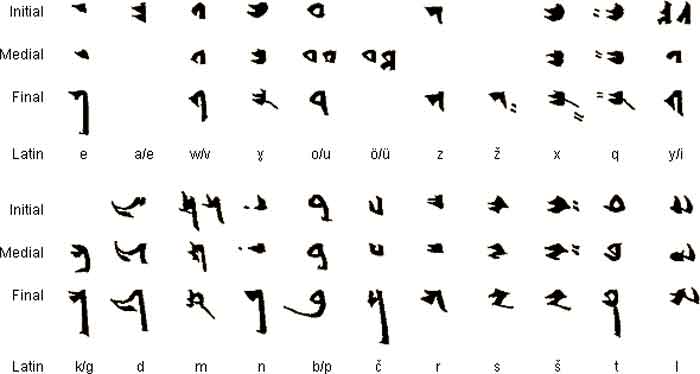|
- Catalog (in stock)
- Back-Catalog
- Mail Order
- Online Order
- Sounds
- Instruments
- Projects
- History Face
- ten years 87-97
- Review Face
- our friends
- Albis Face
- Albis - Photos
- Albis Work
- Links
- Home
- Contact
- Profil YouTube
- Overton Network
P & C December 1998
- Face Music / Albi
- last update 03-2016
|
Old Uighur alphabet
Uighur (Uigur, Uiguir, Uighuir, Uygur, Uyghur, Uygur, Uyghur ) is a Turkic language with about 10 million speakers mainly in the Xinjiang Uyghur Autonomous Region of China, and also in Afghanistan, Kazakhstan, Kyrgyzstan, Mongolia, Pakistan,
Tajikistan and Uzbekistan.
Uighur was originally written with the Orkhon alphabet, a cuniform script derived from or inspired by the Sogdian script, which was ultimately derived from the Aramaic script.
Between the 8th and the 16th century, Uighur was written with an alphabet derived from Sogdian known as old Uighur. Unlike Sogdian, which was written from the right to the left in horizontal lines, the Old Uighur alphabet was written from the left to the right in vertical columns, or in other words, it was a version of Sogdian, rotated 90° to the left. Uighur was also written with the Syriac alphabet, mostly in Christian documents.
From the 16th century to the early 20th century, Uighur was written with a version of the Arabic alphabet known as 'Chagatai'. During the 20th century, a number of versions of the Latin and Cyrillic alphabets were adopted to write Uighur in different Uighur-speaking regions. The Latin alphabet, however, was unpopular, and in 1987 the Arabic script was reinstated as the official script for Uighur in China.
|
Old Uighur alphabet
|
|
Most of the Old Uighur letters have different shapes depending on their position in a word. The initial shapes are used at the beginning of words, the medial shapes in the middle, and the final shapes at the ends of words. |
|
 |
|
December 2010 – Albi
|
PageTop

|
|
